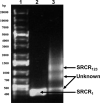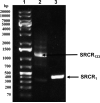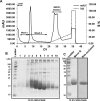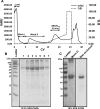Cloning, expression and purification of the SRCR domains of glycoprotein 340
- PMID: 23707657
- PMCID: PMC3727412
- DOI: 10.1016/j.pep.2013.05.003
Cloning, expression and purification of the SRCR domains of glycoprotein 340
Abstract
Glycoprotein 340 (gp340), an innate immunity molecule is secreted luminally by monolayered epithelia and associated glands within the human oral cavity. Gp340 contains 14 scavenger receptor cysteine rich (SRCR) domains, two CUB (C1r/C1s Uegf Bmp1) domains and one zona pellucida (ZP) domain. Oral streptococci are known to adhere to the tooth immobilized gp340 via its surface protein Antigen I/II (AgI/II), which is considered to be the critical first step in pathogenesis that eventually results in colonization and infection. In order to decipher the interactions between gp340's domains and oral streptococcal AgI/II domains, we undertook to express human gp340's first SRCR domain (SRCR1) and the first three tandem SRCR domains (SRCR123) in Drosophila S2 cells. While our initial attempts with human codons did not produce optimal results, codon-optimization for expression in Drosophila S2 cells and usage of inducible/secretory Drosophila expression system (DES) pMT/BiP/V5-HisA vector greatly enhanced the expression of the SRCR domains. Here we report the successful cloning, expression, and purification of the SRCR domains of gp340. Recognition of expressed SRCRs by the conformational dependent gp340 antibody indicate that these domains are appropriately folded and furthermore, surface plasmon resonance studies confirmed functional adherence of the SRCR domains to AgI/II.
Keywords: DMBT1; SAG; SRCR; Streptococcus mutans; gp340.
Copyright © 2013 Elsevier Inc. All rights reserved.
Figures








Similar articles
-
The calcium-induced conformation and glycosylation of scavenger-rich cysteine repeat (SRCR) domains of glycoprotein 340 influence the high affinity interaction with antigen I/II homologs.J Biol Chem. 2014 Aug 8;289(32):21877-87. doi: 10.1074/jbc.M114.565507. Epub 2014 Jun 12. J Biol Chem. 2014. PMID: 24923446 Free PMC article.
-
Hensin, the polarity reversal protein, is encoded by DMBT1, a gene frequently deleted in malignant gliomas.Am J Physiol. 1999 Aug;277(2):F277-89. doi: 10.1152/ajprenal.1999.277.2.F277. Am J Physiol. 1999. PMID: 10444583
-
Deleted in malignant brain tumors-1 protein (DMBT1): a pattern recognition receptor with multiple binding sites.Int J Mol Sci. 2010;11(12):5212-33. doi: 10.3390/ijms1112521. Epub 2010 Dec 17. Int J Mol Sci. 2010. PMID: 21614203 Free PMC article. Review.
-
Identification of the bacteria-binding peptide domain on salivary agglutinin (gp-340/DMBT1), a member of the scavenger receptor cysteine-rich superfamily.J Biol Chem. 2002 Aug 30;277(35):32109-15. doi: 10.1074/jbc.M203788200. Epub 2002 Jun 5. J Biol Chem. 2002. PMID: 12050164
-
The Scavenger Receptor Cysteine-Rich (SRCR) domain: an ancient and highly conserved protein module of the innate immune system.Crit Rev Immunol. 2004;24(1):1-37. doi: 10.1615/critrevimmunol.v24.i1.10. Crit Rev Immunol. 2004. PMID: 14995912 Review.
Cited by
-
Proteins, pathogens, and failure at the composite-tooth interface.J Dent Res. 2014 Dec;93(12):1243-9. doi: 10.1177/0022034514550039. Epub 2014 Sep 4. J Dent Res. 2014. PMID: 25190266 Free PMC article. Review.
-
Structure-Function Characterization of Streptococcus intermedius Surface Antigen Pas.J Bacteriol. 2021 Sep 23;203(20):e0017521. doi: 10.1128/JB.00175-21. Epub 2021 Aug 2. J Bacteriol. 2021. PMID: 34339301 Free PMC article.
-
The catalytic domains of Streptococcus mutans glucosyltransferases: a structural analysis.Acta Crystallogr F Struct Biol Commun. 2023 May 1;79(Pt 5):119-127. doi: 10.1107/S2053230X23003199. Epub 2023 May 5. Acta Crystallogr F Struct Biol Commun. 2023. PMID: 37158310 Free PMC article.
-
The calcium-induced conformation and glycosylation of scavenger-rich cysteine repeat (SRCR) domains of glycoprotein 340 influence the high affinity interaction with antigen I/II homologs.J Biol Chem. 2014 Aug 8;289(32):21877-87. doi: 10.1074/jbc.M114.565507. Epub 2014 Jun 12. J Biol Chem. 2014. PMID: 24923446 Free PMC article.
-
The Glycoprotein 340's Scavenger Receptor Cysteine-Rich Domain Promotes Adhesion of Staphylococcus aureus and Pseudomonas aeruginosa to Contact Lens Polymers.Infect Immun. 2022 Jan 25;90(1):e0033921. doi: 10.1128/IAI.00339-21. Epub 2021 Oct 18. Infect Immun. 2022. PMID: 34662210 Free PMC article.
References
-
- Almstah IA, Wikstrom M, Stenberg I, Jakobsson A, Fagerberg-Mohlin B. Oral microbiota associated with hyposalivation of different origins. Oral Microbiol Immunol. 2003;18:1–8. - PubMed
-
- Moore WE, Moore LV. The bacteria of periodontal diseases. Periodontol 2000. 1994;5:66–77. - PubMed
-
- Hajishengallis G, Koga T, Russell MW. Affinity and specificity of the interactions between Streptococcus mutans antigen I/II and salivary components. J Dent Res. 1994;73:1493–1502. - PubMed
MeSH terms
Substances
Grants and funding
LinkOut - more resources
Full Text Sources
Other Literature Sources
Miscellaneous

